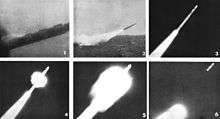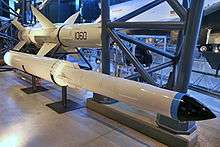UUM-44 SUBROC
| UUM-44 SUBROC | |
|---|---|
 A UUM-44 Subroc after leaving the water. | |
| Type | Standoff anti-submarine weapon |
| Place of origin | United States |
| Service history | |
| In service | 1965-1989 |
| Used by | United States Navy |
| Production history | |
| Manufacturer | Goodyear Aerospace |
| Specifications | |
| Weight | 4,000 lb (1,800 kg) |
| Length | 22 ft (6.7 m) |
| Diameter | 21 in (53 cm) |
| Warhead | W55 1-5 kt[1] nuclear depth bomb |
Detonation mechanism | Depth Fuze |
|
| |
| Engine | Solid rocket booster |
Operational range | 55 km (34 mi) |
| Speed | subsonic |
Guidance system | Inertial guidance ballistic trajectory |
Launch platform | Submarine |
The UUM-44 SUBROC (SUBmarine ROCket) was a type of submarine-launched rocket deployed by the United States Navy as an anti-submarine weapon. It carried a 5 kiloton nuclear warhead.[1]
Development


Development began in 1958, with the technical evaluation being completed in 1963. That year, the US Navy received the first rounds and soon reached Initial Operation Capability (IOC) aboard the attack submarine Permit.[2] When SUBROC reached IOC The US Navy's admiral in charge of weapons procurement stated that SUBROC was " .. a more difficult technical problem than Polaris." [3] SUBROC was never used in combat, and all were decommissioned following the end of the Cold War in 1989. Because the nuclear warhead was an integral part of the weapon, SUBROC could not be exported to other navies, and there is no evidence that any were supplied to other NATO allies under the well-established arrangements for supplying other dual-key nuclear weapons. Towards the end of the 1970s, a planned successor, the UUM-125 Sea Lance, was frequently delayed due to funding problems and eventually canceled.
Operation
SUBROC could be launched from a 21 inch submarine torpedo tube. After launch, the solid fuel rocket motor fires and SUBROC rises to the surface. The launch angle then changes and SUBROC flies to its destination following a predetermined ballistic trajectory. At a predetermined time in the trajectory, the reentry vehicle (containing the warhead) separates from the solid fuel motor. The warhead, a W55 1 to 5 kiloton[1] nuclear depth bomb, drops into the water, sinking rapidly before exploding in proximity to its target. A direct hit was not necessary.
Technically, its tactical use was as an urgent-attack long-range weapon that could attack time-urgent submarine targets that could not be attacked with any other weapon without betraying the position of the launching submarine by calling for an air-strike, or where the target was too distant to be attacked quickly with a torpedo launched from the submarine. The tactical rationale for SUBROC was similar to that for ASROC or Ikara. An added advantage was that SUBROC's approach to the target was not detectable by the target in time to take evasive action, although the warhead yield would appear to make evasive maneuvers unrealistic. However, SUBROC was less flexible in its use than Ikara or ASROC: since its only payload was a nuclear warhead, it could not be used to provide stand-off fire in a conventional (i.e., non-nuclear) engagement.
See also
References
- Jackson, Robert. Submarines of the World, Pg. 312